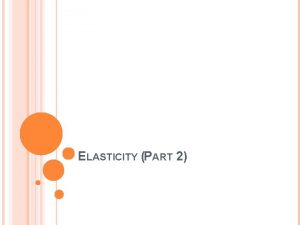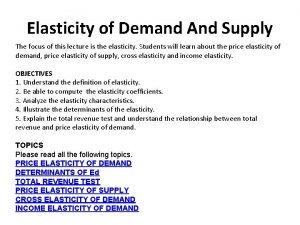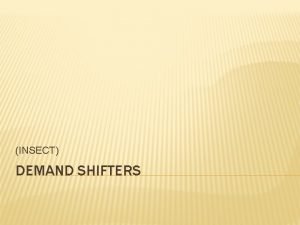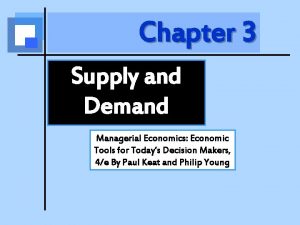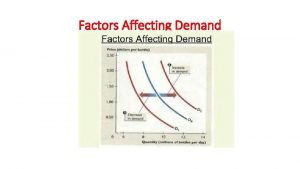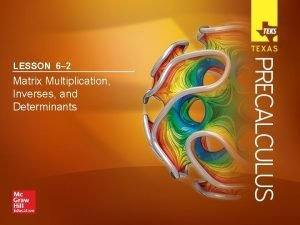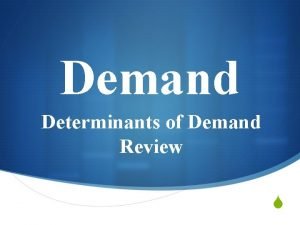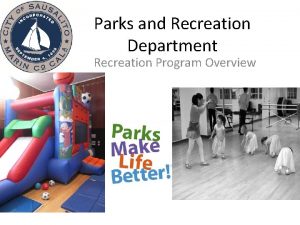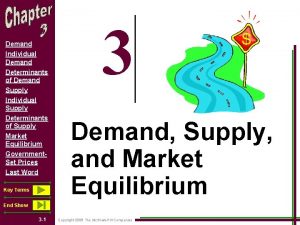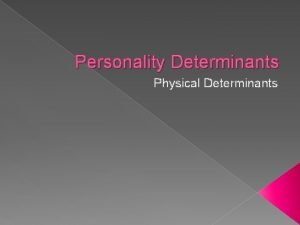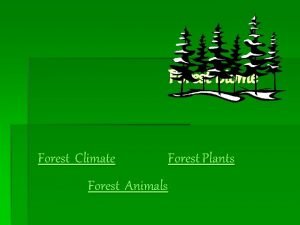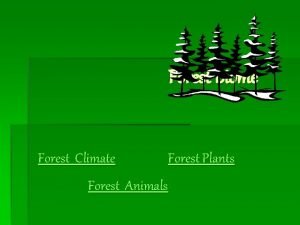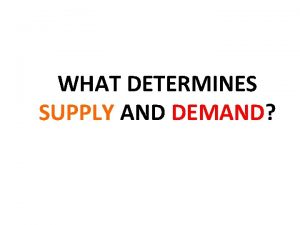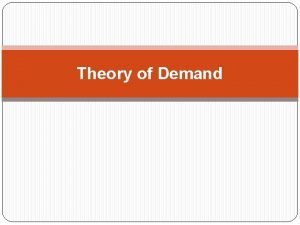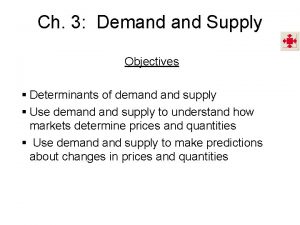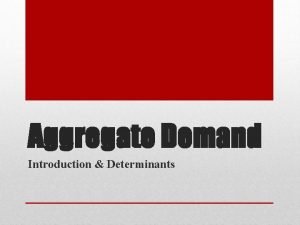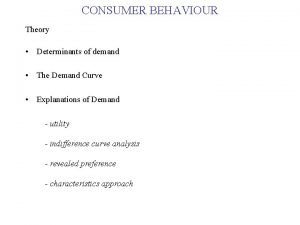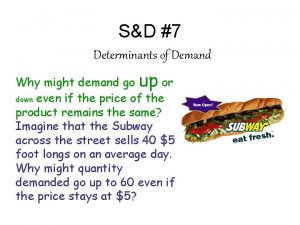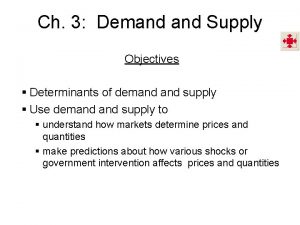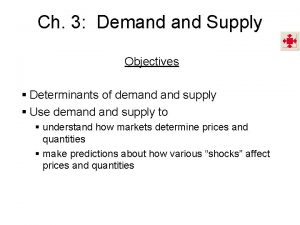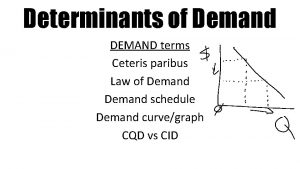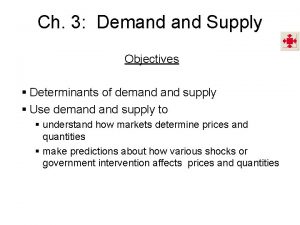Determinants of demand forest recreation Forest and population






















- Slides: 22

Determinants of demand forest recreation: Forest and population characteristics Jens Abildtrup, INRA, UMR 356 LEF, F-54000 Nancy, France Serge Garcia INRA, UMR 356 LEF, F-54000 Nancy, France Soren Bøye Olsen, Copenhagen University, 1958 Frederiksberg C, Denmark Anne Stenger INRA, UMR 356 LEF, F-54000 Nancy, France LEF workshop May 31 – June 1, 2012, Nancy 1

Background • Lorraine: • 37 % forest (F 25%) • Short travel distance ( 13 km) • High frequency use of forests (26 visits per year) Recreational activities i Lorraine Forest Lakes or beaches Other country side. . . Urban parcs Sport sites Museum Cinema 0 10 20 30 Number of times going to a recreation site annually Source: LEF 2010 survey

Overall objectives and approach • Estimate the determinants of demand forest recreation • Forest characteristics • Accounting for substitution and complementary sites – spatial explicit • Socio-demographic characteristics of population • Overall approach • Travel cost method based on revealed and stated travel behaviour • Data enrichment • Reduce problems of multicollinarity and forest attribute endogeneity 3

Methodological issues • Large choice sets: >5000 forest units in Lorraine, ~ 125 different forests within 20 minutes by car Þ Site selection model (Random utility model) and trip demand model (“linked model), Bockstael et al. 1988, Hausman et al. 1995 JPE Þ Sampling in choice set, Feather et al. 1994 AJAE, Nerella and Bhat 2004 Trans. Res. B Þ Identification of visited forests: Use of Google map • Comparison of revealed and stated preferences =>Error component mixed logit: Bhat et Castelar 2002 Trans. Res. B, Hensher 2008, Res in Transp. Econ; • >30% walk or go by bicycle to forest => implications for travel costs Þ model transport mode choice explicitly, Bell and Strand 2003 Land Econ. 4

Outline 1. Methodology applied 2. Survey and data 3. Results 4. Discussion and perspectives

Methodology: The linked model (overview) The linked model: e. g. Bockstael et al. 1987, Hausman et al. 1995 JPE Stage 1: Site selection model – Random Utility Model (RUM) Stage 2: Trip demand model – negative binominal model The link between the two stages: Expected utility or consumer surplus of one trip

Methodology: Site selection Combining RP and SP data. Utility by individual n visiting forest j in choice situation t SP RP

Methodology: Site and transport mode selection The utility function for individual n for visiting forest j with transport mode m

Methodology: The linked model Assuming εnk is i. i. d. extreme value the expected maximum utility of one trip to a forest (the link): Assuming random parameters the expected value should be simulated using estimated parameter distributions:

Methodology: The linked model II 1. Trip demand model: negative binominal model Where the probability of tn visits in forest during 12 months is Where

Data: The survey • Web-based questionnaire send to random sample in Lorraine 2010: • Previous use of forests for recreation • Choice experiment on hypothetical use of forests • Characteristics of the respondent • Location identified by municipality (commune Small administrative unit)

The survey Where is the forest located where you have gone most often during the last 12 months ? Click on the forest on the map Self-reporting: I have found the forest 88. 9% I didn’t find the forest because it was to difficult 6. 5% I have not found the forest because it was the map was not appropriate for locating the forest 4. 6%

The survey Defining a forest relevant recreation? Forests in Lorraine Google Map Where the forest are located

Choice set example Choose the forest you would have gone to if the two alternative forest existed when you went to the forest the last year Alternative 1 Alternative 2 Characteristics of the forests The forest you visited most often the last year Dominant tree species Mixed tree species Conifers One path No paths More paths Parking No No water Lake or river Parking and picnic No water 13 km 5 km 20 km Trekking paths Recreational facilities Access to wetland Distance from your home I prefer …(tick one):

Attributes Describe the forest you have visited most often the last 12 months Tree species Trekking paths Facilities Water Distance between residence and forest Cochez une possibilité Broadleaves q Conifers q Mixed species q Cochez une possibilité No trekking paths q One trekking path q q More than one trekking path Cochez une possibilité none q Parking q Picnic q Parking and picnic q Cochez une possibilité no q Lake or river q _______km

Data: Sample representativeness 818 usable responses (526 had visited forest and had identified visited forest) 2% response rate (as expected from this internet panel) Overweight of • Males • Elderly males • Middle-aged females • High income

Results – common SP and RP parameters Variable Broadleaves Mixed species One trekking path More than one trekking road Parking or picnic Parking and picnic Lake and/or river Distance (km) Private forest Private and public forest Standard dev. of altitude Log(area) Probability of finding blueberries ASC 1 (Status quo alternative) ASC 2 Random parameters SP and RP Derived standard deviations of parameter data distributions Coefficient P[|Z|>z] *** 0. 79 *** 0. 000 0. 49 0. 002 *** 0. 90 *** 0. 000 0. 86 0. 000 *** 0. 55 *** 0. 000 0. 40 0. 009 *** 0. 72 *** 0. 000 0. 89 0. 000 *** RP & 0. 21 ** 0. 016 0. 57 0. 001 *** 0. 15 0. 113 0. 85 0. 000 *** 0. 63 *** 0. 000 0. 47 0. 000 *** -0. 13 *** 0. 000 0. 13 0. 000 -0. 45 *** 0. 012 0. 01 0. 979 -0. 21 0. 110 0. 17 0. 415 0. 00 0. 976 0. 00 0. 888 RP 0. 66 *** 0. 000 0. 974 0. 47 0. 597 0. 35 0. 791 *** 0. 39 *** 0. 000 0. 91 0. 000 *** 0. 00 2. 0 0. 000 Mc. Fadden Pseudo R-squared N=526 Number of choices =526*7=3682 *: p<0. 1, **: p<0. 05, ***: p<0. 01 0. 72 17 SP

Results: SP and RP Variable Broadleaves Mixed species One trekking path More than one trekking road Parking or picnic Parking and picnic Lake and/or river Distance (km) Private forest Private and public forest Standard dev. of altitude Log(area) Probability of finding blueberries ASC 1 (Status quo alternative) ASC 2 *: p<0. 1, **: p<0. 05, ***: p<0. 01 Coefficient P[|Z|>z] Coefficient SP data RP data 0. 78 *** 0. 0000 0. 45 1. 01 *** 0. 60 0. 0000 0. 39 *** 0. 53 *** 0. 0000 0. 61 *** 0. 33 0. 0000 0. 11 0. 68 *** 0. 1831 0. 077 0. 78 *** 0. 3806 0. 64 *** 0. 38 ** 0. 0000 -0. 044 *** 0. 0000 -0. 38 *** -0. 59 ** -0. 27 -0. 0087 0. 82 *** 1. 71 0. 458 *** 0. 000 0 - P[|Z|>z] 0. 3366 0. 1421 0. 0038 0. 1774 0. 0099 0. 0069 0. 0348 0. 0000 0. 0189 0. 1450 0. 1204 0. 0000 0. 2144 18

Comparison of marginal WTP (Unit=km) Variable Dataset-specific parameters WTP SP data WTP RP data Common parameters WTP RP & SP data Broadleaves Mixed species One trekking path More than one trekking road Parking or picnic 19. 47 24. 22 9. 81 15. 33 2. 68 1. 24 1. 8 1. 71 1. 11 2. 32 7. 79 8. 65 6. 18 6. 99 1. 95 Parking and picnic Lake and/or river Distance (km) Private forest Private and public forest Standard dev. of altitude Log(area) Probability of finding blueberries ASC 1 (Status quo alternative) 2. 80 14. 80 - 2. 6 1. 26 -1. 93 -0. 77 -0. 03 2. 60 2. 97 1. 68 6. 24 -4. 43 -2. 23 0. 00 6. 78 6. 35 5. 49 1. 50 RP & SP RP ASC 2 NB: Bold numbers: where marginal utility is significant – significance of the marginal WTP has not been tested explicitly 19

Results: RP data, Transport mode choice Variable Broadleaves Mixed species One trekking path More than one trekking road Trekker*one trekking path Trekker*more trekking paths Parking Lake and/or river Travel cost car (car cost and time cost) Travel cost walking (alternative time cost) Private forest Private and public forest Standard dev. of altitude Log(area) Number of attractions ASC for car mode Mc. Fadden Pseudo R-squared N=526 Number of choices=526 Coefficient 0. 29 0. 42 0. 71 0. 077 2. 1 0. 83 0. 92 0. 038 -0. 47 -0. 10 -0. 87 -0. 48 -0. 001 0. 80 0. 026 -3. 0 0. 56 *** *** *** P[|Z|>z] 0. 573 0. 389 0. 094 0. 771 0. 003 0. 454 0. 001 0. 839 0. 000 0. 003 0. 015 0. 934 0. 000 0. 542 0. 000 20

Trip model – number of visits in forest Variable Constant Inclusive value Population density Share of urban green space in the town Income Female Hunter Forest owner Higher education Lives in an apartment Often buying organic products Member of a trekking club Lives with a partner Alpha (over dispersion) N Coefficient 1. 63 *** 0. 09 *** -0. 019 -0. 29 P[|Z|>z] 0. 007 0. 009 0. 361 0. 893 -0. 034 ** -0. 48 *** 0. 86 *** 0. 45 *** 0. 14 -0. 21 *** 0. 20 *** 0. 55 *** -0. 24 ** 0. 048 0. 000 0. 001 0. 189 0. 052 0. 000 0. 001 0. 013 1. 40 818 *** 0. 000 21

Discussion and perspectives • People (our sample) can identify a visited forest on a (Google) map • Results based on stated and revealed preferences data differ in our case • What data to use for policy analysis? • Possible to cope with transport mode choice explicitly in a RPL model 24
 What are the 5 determinants of price elasticity of demand
What are the 5 determinants of price elasticity of demand What are the 5 determinants of price elasticity of demand
What are the 5 determinants of price elasticity of demand What are the 5 determinants of price elasticity of demand
What are the 5 determinants of price elasticity of demand Shifters in demand
Shifters in demand Demand and supply analysis in managerial economics
Demand and supply analysis in managerial economics Non price determinants of supply
Non price determinants of supply Determinants of demand
Determinants of demand Module 5 supply and demand introduction and demand
Module 5 supply and demand introduction and demand Measures to correct excess demand and deficient demand
Measures to correct excess demand and deficient demand Independent demand vs dependent demand
Independent demand vs dependent demand Schedule ng supply
Schedule ng supply Demand forecasting managerial economics
Demand forecasting managerial economics Distinguish between individual demand and market demand
Distinguish between individual demand and market demand Dependent demand items
Dependent demand items Chapter 4 population ecology answer key
Chapter 4 population ecology answer key Section 1 population dynamics answer key
Section 1 population dynamics answer key Population ecology section 1 population dynamics
Population ecology section 1 population dynamics Chapter 4 population dynamics study guide answers
Chapter 4 population dynamics study guide answers Stochastic inventory model example
Stochastic inventory model example Individual demand vs market demand
Individual demand vs market demand Independent demand vs dependent demand
Independent demand vs dependent demand Family and morale welfare and recreation
Family and morale welfare and recreation Multiplication of determinants
Multiplication of determinants
